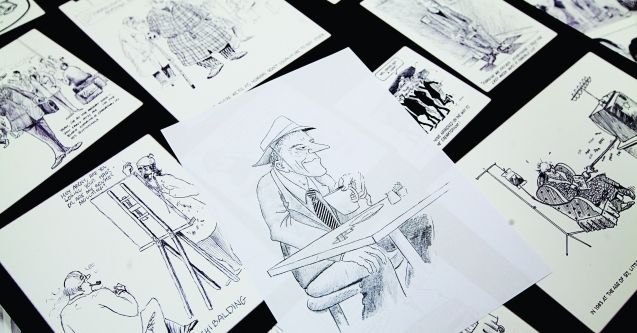Diamond in the rough
2 July 2015

Caption: A selection of just some of the many drawing and short stories Tony produced.
About 25 years ago, Tony Dixon turned up at The Salvation Army’s William Booth Institute in Surry Hills, Sydney. He was requesting admission for the drug and alcohol rehabilitation Bridge Program – for a record-breaking 17th time.
Major Brian Watters, who had just been appointed manager of the institute, recalls the moment: “Tony looked like the father in Steptoe and Son – a little, shrivelled-up old bloke. I felt God saying to me, ‘Give him a go.’ If a man’s made 17 attempts, there must be something good driving him; I’d like to meet him. Tony came in and never looked back.”
Tony (now deceased) was born in London in 1937. When he was eight, he and his siblings were placed in a children’s home, then, in 1954, they came to Australia to live with their uncle who was a violent alcoholic.
From the age of 17, alcohol became Tony’s escape from this man and his memories. Thus began his spiral of addiction, which would haunt him for more than 30 years.
Underneath his alcoholism, Tony was a creatively gifted man. As part of his many attempts at recovery, in 1976 he volunteered his copper craft and leatherwork skills at the Sydney City Mission in Glebe.
Sixteen times Tony went in and out of The Salvation Army’s Bridge Program, never quite reaching sobriety.
New man emerges
While attempting to recover from his addiction for the 17th time, Tony began to explore his relationship with God.
“He got stuck into the Bible and began to see things in the New Testament that he felt he had to apply to his own life,” says Major Watters. “Tony was carrying a tremendous burden of hate. I’d tell him, ‘One of the reasons you’re drinking is to try and deal with all this hatred and bitterness and anger inside of you ... you’re going to have to forgive’.
“Gradually we saw a change – he was like a butterfly coming out of the chrysalis. He’d talk about his spiritual struggles and how he had to let certain things go and needed the grace of God to do it.”
Tony acknowledged the transformation he’d experienced through the Bridge Program. “I have to believe today that God performed a little miracle through his servants The Salvation Army, who led me into wholesomeness via their more Christian interpretation of the program of Alcoholics Anonymous,” he wrote at the time.
As Tony healed, discovered God and overcame his addiction, his suppressed creativity began to emerge once more. He wrote short stories and poetry, and drew cartoons and posters – some of which are still in use today at William Booth House.
Finding ‘belongment’
After achieving sobriety, Tony moved to Leichhardt, where he found a permanent place to belong. In 1996, he became an Australian citizen and coined the word “belongment” as an expression of his emotions.
Tony once explained the meaning of his word “belongment” as “Someone loving to be with, somewhere to go, something to do.”
In 2002, Tony finally had his first stable home. It was then he began drawing portraits for members of the community as a sign of his friendship.
Although many people left their impact on Tony, he left his on many more.
“Tony revealed to me you should never judge a person by their appearance, and you should never give up on someone,” shares Major Watters, who remained in contact with Tony until his death in 2007.
“When I first met Tony, I felt it was the right thing to admit him. I’m eternally grateful that we did. I believe it was God-inspired.”
By Julia Hosking
Photo Credit: Shairon Paterson.
Comments
No comments yet - be the first.